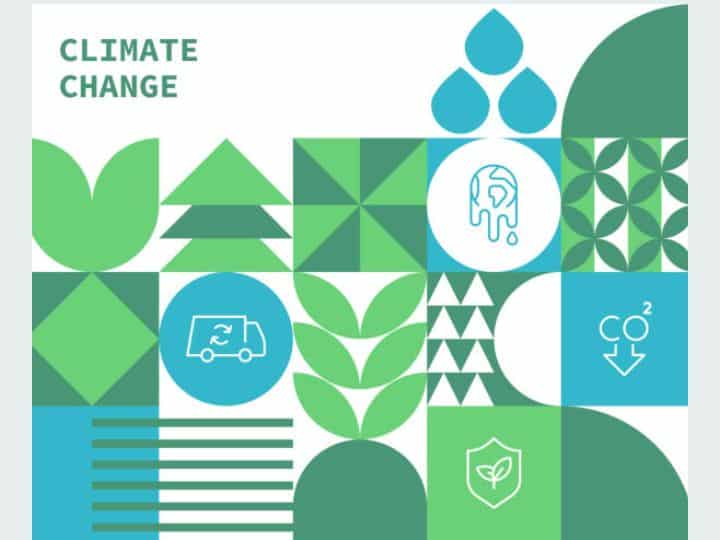Climate change is one of the most pressing global challenges of the 21st century. Driven by the accumulation of greenhouse gases (GHGs) in the atmosphere—primarily carbon dioxide (CO2) from the burning of fossil fuels—climate change is causing rising global temperatures, sea-level rise, extreme weather events, and disruptions to ecosystems. The scientific consensus is clear: to prevent catastrophic impacts, global temperatures must be limited to below 1.5°C above pre-industrial levels, and this requires substantial reductions in GHG emissions.

One of the most effective ways to achieve this goal is through the widespread adoption of renewable energy sources, which can replace fossil fuels and reduce emissions. This article explores the relationship between climate change and renewable energy, the importance of transitioning to renewable energy, and the challenges and opportunities in creating a sustainable energy future.
1. The Science of Climate Change and the Role of Energy Consumption Climate change is fundamentally a problem of excessive greenhouse gas emissions, which trap heat in the Earth’s atmosphere. The burning of fossil fuels—such as coal, oil, and natural gas—releases CO2 and other GHGs into the air. These emissions have led to a steady rise in global temperatures, triggering various environmental and social challenges, such as more frequent and severe heat waves, droughts, storms, and flooding. Scientists agree that human activity, particularly in energy production, agriculture, and deforestation, is the primary driver of climate change.
The energy sector is the largest contributor to global greenhouse gas emissions. According to the International Energy Agency (IEA), around 73% of total global GHG emissions come from energy-related activities, with electricity and heat production accounting for approximately 40% of these emissions. In particular, fossil-fuel-powered electricity generation and transportation are major culprits in driving global warming. Therefore, transitioning to clean, renewable energy is essential to mitigating climate change and meeting international climate targets such as those outlined in the Paris Agreement.
2. The Need for Renewable Energy Renewable energy sources—such as solar, wind, hydropower, geothermal, and biomass—offer a sustainable alternative to fossil fuels. These energy sources have several key advantages:Sustainability and Low Emissions: Unlike fossil fuels, renewable energy sources do not emit greenhouse gases when generating electricity. Solar panels, wind turbines, and hydropower plants produce clean energy with minimal environmental impact once they are up and running.

Energy Security and Independence: Renewables can be locally sourced, reducing dependence on imported fossil fuels and improving energy security. Countries that invest in renewable energy infrastructure can reduce the geopolitical risks associated with the volatility of global energy markets.Economic Growth and Job Creation: The renewable energy sector has been a significant driver of job creation and economic growth. According to the International Renewable Energy Agency (IRENA), the renewable energy sector employed 12 million people globally in 2020, with projections suggesting that this number could rise as countries transition to cleaner energy systems.Technological Innovation and Cost Reductions: The rapid advancement of renewable energy technologies, particularly in solar and wind power, has driven down costs. The levelized cost of energy (LCOE)—which measures the per-unit cost of energy production—has fallen dramatically in recent years. For instance, solar and onshore wind energy are now among the cheapest sources of electricity in many parts of the world, making them increasingly competitive with fossil fuels.
3. The Impact of Renewable Energy on Climate Change Mitigation
Transitioning to renewable energy is one of the most effective ways to reduce GHG emissions and combat climate change. As renewable energy technologies become more cost-effective and widely deployed, they are helping to decarbonize electricity generation and other sectors, such as transportation and industry. Here’s how renewables can contribute to climate change mitigation:Decarbonizing the Power Sector: .
The power sector is the largest source of global emissions, and renewable energy is the key to reducing these emissions. Solar, wind, and hydropower can provide reliable, low-carbon electricity without the need for fossil fuels. Many countries are already seeing the benefits of this transition. For example, in Denmark, wind power accounts for over 40% of the country’s electricity generation, while in Germany, solar and wind energy together account for around 50% of the national power grid.Electrifying Transportation: The transportation sector is another major emitter of GHGs, especially in countries that rely on gasoline and diesel-powered vehicles. By transitioning to electric vehicles (EVs) and charging them with renewable energy, emissions from transportation can be drastically reduced. In addition, EVs are becoming more affordable, and charging infrastructure is expanding rapidly in many regions, making clean transportation more accessible.
Energy Storage and Grid Flexibility: A key challenge for renewable energy is its intermittency—solar and wind power are variable by nature, depending on weather conditions. However, advancements in energy storage technologies, such as batteries, are making it increasingly feasible to store excess renewable energy for use when demand is high or when renewable generation is low. This helps to balance the grid and ensures that renewable energy can provide a stable and reliable power supply.Industry and Heating: Renewable energy is also being integrated into industrial processes and heating systems. For example, geothermal energy can be used for heating and cooling, while bioenergy can replace fossil fuels in industrial heating applications. Additionally, innovations in hydrogen production—using renewable electricity to produce green hydrogen—hold the potential to decarbonize heavy industries such as steel production, cement manufacturing, and chemical processing.
4. Challenges in Transitioning to Renewable Energy While the potential of renewable energy to combat climate change is immense, several challenges remain in transitioning to a global, low-carbon energy system:Infrastructure and Investment: Transitioning to renewable energy requires significant investment in infrastructure, such as grid modernization, energy storage systems, and renewable energy installations. Many countries, especially developing ones, may face financial and logistical challenges in scaling up renewable energy projects. Public-private partnerships and international cooperation will be key in securing the necessary funding and resources.
Energy Transition in Developing Countries: Many developing countries are still heavily reliant on coal and other fossil fuels for electricity generation. While renewable energy is becoming more affordable, the initial investment required to build renewable energy infrastructure can still be a barrier. However, renewable energy can also provide a leapfrogging opportunity for these nations to avoid the environmental and economic costs of fossil fuel dependence.

Policy and Regulatory Barriers
Governments play a critical role in shaping the energy transition through policies, incentives, and regulations. In some regions, fossil fuel subsidies remain entrenched, making it difficult for renewable energy to compete on equal footing. A clear and consistent policy framework that supports renewables—such as carbon pricing, subsidies for clean energy technologies, and renewable energy standards—is essential for driving the transition.Social and Political Resistance.
The transition to renewable energy can face resistance from vested interests, including fossil fuel industries and communities dependent on fossil fuel jobs. In many regions, the shift away from coal, oil, and gas could have social and economic implications, such as job losses and regional economic decline. Therefore, just transition policies—such as retraining programs, social safety nets, and support for affected communities—are critical to ensuring that the transition to a low-carbon economy benefits all.
5. The Role of Innovation and Collaboration to overcome these challenges and accelerate the transition to renewable energy, innovation and collaboration are essential. The development of new technologies, such as advanced nuclear energy, carbon capture and storage (CCS), and next-generation energy storage solutions, can complement renewable energy and help decarbonize difficult-to-abate sectors. Furthermore, global cooperation is needed to share knowledge, technology, and financing, particularly for developing countries.International agreements like the Paris Agreement provide a framework for nations to work together toward common climate goals, including increasing the share of renewable energy in the global energy mix.
As countries set more ambitious climate targets and renewables continue to scale, the potential for a cleaner, more sustainable energy future is within reach.
Conclusion
Climate change is an urgent global challenge that requires a swift and transformative shift in how we produce and consume energy. Renewable energy provides a viable solution to reduce greenhouse gas emissions, mitigate the impacts of climate change, and build a sustainable future. While challenges remain in transitioning to renewable energy, the technological advancements, economic benefits, and growing international commitment to clean energy offer hope for a low-carbon future.
The next decade will be crucial in determining whether the world can accelerate the adoption of renewable energy and meet the climate targets necessary to avoid the worst impacts of climate change. Through innovation, collaboration, and strong policy frameworks, renewable energy can play a central role in securing a sustainable, resilient planet for future generations.




